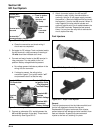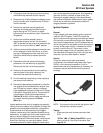
5B.11
Section 5B
EFI Fuel System
5B
Figure 5B-12. Cutaway of Oxygen Sensor.
The oxygen sensor can function only after being
heated by exhaust temperatures to a minimum of
375°C (709°F). A cold oxygen sensor will require
approximately 1-2 minutes at moderate engine load to
warm sufficiently to generate a voltage signal. Proper
grounding is also critical. The oxygen sensor grounds
through the metal shell, so a good, solid, unbroken
ground path back through the exhaust system
components, engine, and wiring harness is required.
Any disruption or break in the ground circuit can affect
the output signal and trigger misleading fault codes.
Keep that in mind when doing any troubleshooting
associated with the oxygen sensor. The oxygen sensor
can also be contaminated by leaded fuel, certain RTV
and/or other silicone compounds, carburetor cleaners,
etc. Use only those products indicated as “O
²
Sensor
Safe.”
Service
Like the other sensors already discussed, the oxygen
sensor is a non-serviceable component. Complete
replacement is required if it is faulty. The sensor and
wiring harness can be checked as follows.
NOTE: All tests should be conducted with a good
quality, high-impedance, digital VOA meter for
accurate results.
“24 Pin” (MSE 1.0) Plastic-Cased ECU: Check
between the #6 and #4 pin terminals.
“32 Pin” (MSE 1.1) Plastic-Cased ECU: Check
between the #6 and #4 pin terminals.
5. Unplug the sensor connector and check sensor
resistance separately. Resistance value should
again be 2375-2625
ΩΩ
ΩΩ
Ω.
a. If the resistance is out of specifications,
replace the temperature sensor.
b. If it is within specifications, proceed to Step 6.
6. Check the temperature sensor circuits (input,
ground) from the main harness connector to the
corresponding terminal in the sensor plug for
continuity, damage, etc.
“35 Pin” (MA 1.7) Metal-Cased ECU: Pin circuits
#14 and #27.
“24 Pin” (MSE 1.0) Plastic-Cased ECU: Pin
circuits #6 and #4.
“32 Pin” (MSE 1.1) Plastic-Cased ECU: Pin
circuits #6 and #4.
Oxygen Sensor
Figure 5B-11. Oxygen Sensor.
General
The oxygen sensor functions like a small battery,
generating a voltage signal to the ECU, based upon
the difference in oxygen content between the exhaust
gas and the ambient air.
The tip of the sensor, protruding into the exhaust gas,
is hollow (see cutaway Figure 5B-12). The outer
portion of the tip is surrounded by the exhaust gas,
with the inner portion exposed to the ambient air.
When the oxygen concentration on one side of the tip
is different than that of the other side, a voltage signal
typically cycling between 0.2 and 1.0 volt is generated
between the electrodes and sent to the ECU. The
voltage signal tells the ECU if the engine is straying
from the ideal 14.7:1 fuel mixture, and the ECU then
adjusts the injector pulse accordingly.
12
3
4
5
6
7
8
1. Connection Cable
2. Disc Spring
3. Ceramic Support Tube
4. Protective Sleeve
5. Contact Element
6. Sensor Housing
7. Active Ceramic Sensor
8. Protective Tube


















